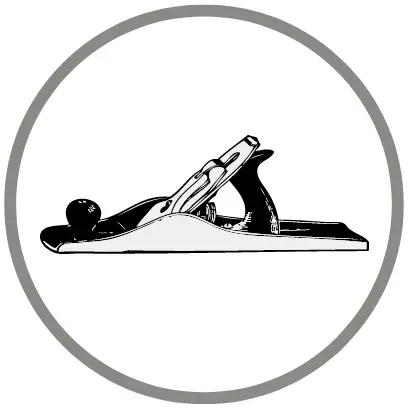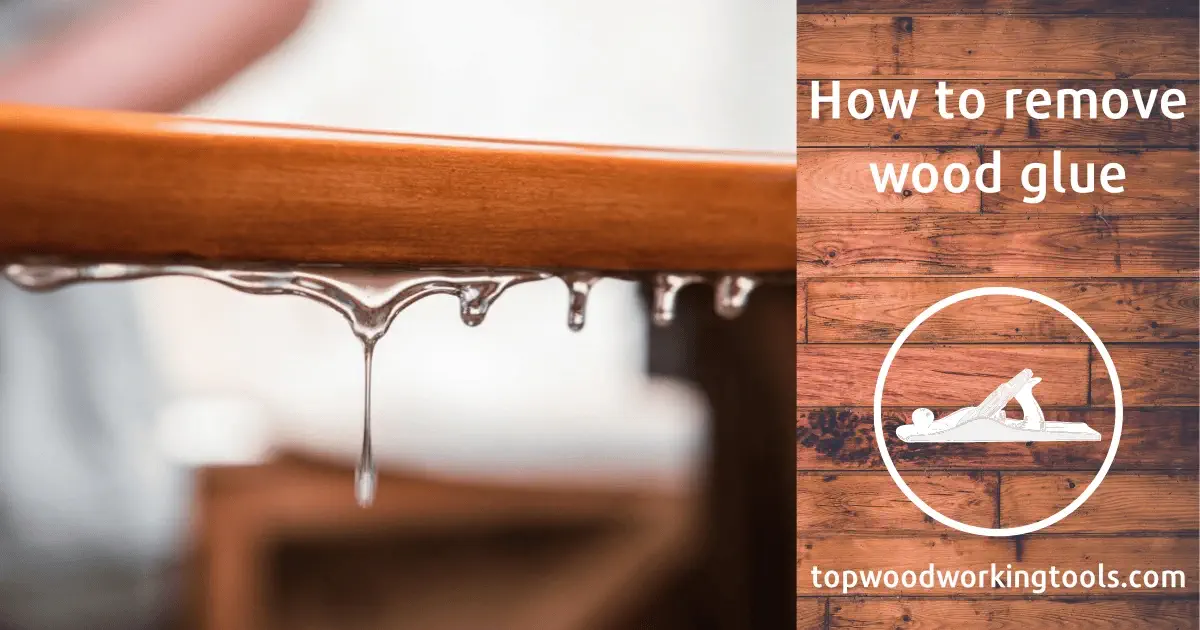Various kinds of glue can end up on virtually any surface, and covering all the possible situations will make no sense. So, let’s focus on the most probable of them.
I will cover basic types of glues on typical surfaces and some ways to remove dried wood glue mechanically, using commercial products, as well as some general household items.
Spills and stains of wood glue are inevitable when it comes to woodworking projects of any scale. But how to remove wood glue (wet glue or dried wood glue) with the least effort possible? That’s what I’ll focus on in this post.
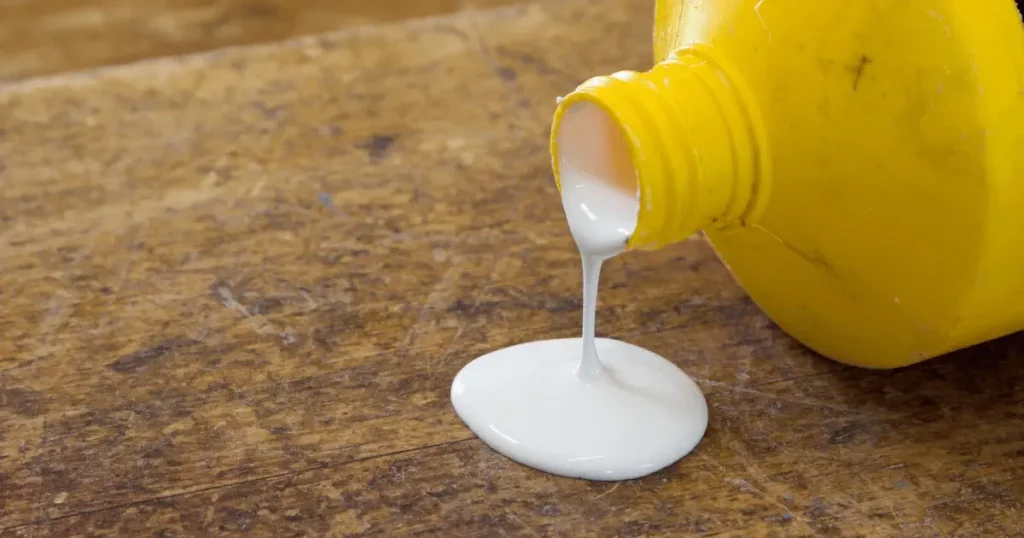
Contents
- 1 Best practices for further projects
- 2 What is wood glue and how it works
- 3 Types of surfaces with glue residue
- 4 Mechanical removal of dried wood glue stains
- 5 How to remove dried wood glue with commercial products?
- 6 How to remove wood glue? Household products and other life-hacks
- 7 Dealing with a wet wood glue stain
- 8 Q&A portion
- 9 Wrapping it up
Best practices for further projects
But before carrying on with the ways to remove wood glue from wood in the form of drops, stains, and puddles that you most likely already have, I would like to share some tricks on how to make your life easier in the rest of the future projects.
First of all, you need to remember that wood glue in thin layers dries to a transparent film. Even if the initial product was yellow.
This film is what’s left behind on the wood surface even after wiping everything with a rag. And you will definitely have to remove glue before carrying on with the project.
Tip. Get more useful information about How long does wood glue take to dry.
The potential harm of dry wood glue stains and residue
A thin layer of dried wood glue has a lot of potential in ruining your stain, paint job, or any other topcoat since it blocks the grain. It will come out as a blotchy area while staining or become a massive bubble in the paint that will eventually break and chip away.
Dealing with squeeze-outs
Considering the properties of most commonly used wood glues in woodworking, some of the best practices are:
- Wipe off the wet wood glue stain or squeeze-out residue with a warm soapy cloth.
- Leaving the residue to dry to be able to remove glue later by sanding and before painting, or sealing in any other way.
- Or let the squeeze-out bids dry and then chip them off with a dedicated scraper or a blunt chisel.
- Masking flat wooden surfaces around the joint with some painter’s tape. This way, you won’t have to remove glue from wood at all.
Either way, sanding before sealing is the best practice since dried glue will leave a thin film which will ruin the staining or painting job. The wet cloth will work a bit better than a dry one, but you can even use some paper towels to get rid of a wood glue stain since sanding will be needed anyway.
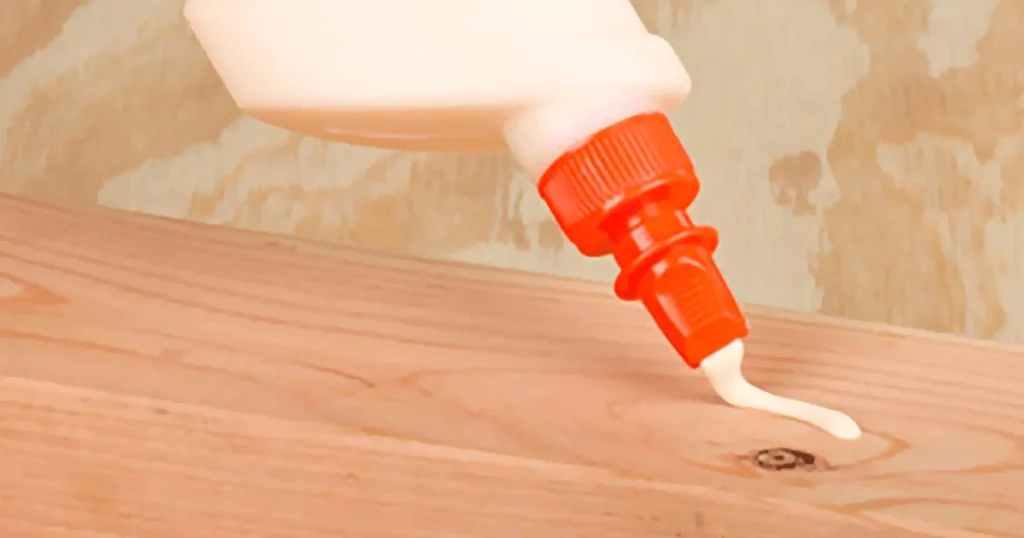
Dealing with spills and splatter
Most likely, you’ll be able to predict where all the excess wet glue that drips out will end up. Some sacrificial tarp or a cutting mat underneath the drying clamped piece will be a great option.
You won’t have to clean, since dried wood glue stain will easily come off most rubber or silicone surfaces. A bit of wiggling the tarp or the mat is all it takes to remove the dried residue.
Silicon mat or a waterproof tarp will work great because a wet glue stain won’t be able to make a strong bond with their surfaces while it dries. It will just sit on top and dry, losing most of its flexibility.
The leftover flexibility won’t be enough for the drops, splatter, and the rest of the excess glue to stay attached to the surface.
Pro-tip: Some old newspapers or a roll of wallpaper left from the previous renovation may seem like a practical option for putting under the drying glued piece to collect excess glue.
But it is not. The wet glue stains will soak through and attach the paper to the wood surface. Removing the resulting mess is harder than just the glue itself.
What is wood glue and how it works
Now there’s time for some traditional theoretical minimum. Several types of glues are commonly used in woodworking:
- polyvinyl acetate or PVA (some types with the addition of some aliphatic resin) based;
- cyanoacrylate-based glue;
- polyurethane-based wood glue;
- wood glues based on collagen derived from animal products (hoof glue, hide glue).
PVA or vinyl glue specially formulated for gluing wood is the most common type of product in woodworking. Its main component is a polymer that bonds to the wood and all the rest of the materials.
In fact, dried glue is stronger than the wood itself. So, to remove glue from wood, you’ll be going to need some chemicals that are capable of dissolving the polymer in glue stains. That would be the majority of solvents and some acids. Aside from mechanical influences such as sanding or heating.
The hardest to remove
Removing glue residue from cyanoacrylate glue is the hardest. It is better to go for specialized commercial products to remove the residue of a major wood glue stain. Fortunately, its use in woodworking is very limited, so you won’t have to deal with a lot of it.
Hide glue or hoof glue are on the other end of the specter. They are water-soluble, so you will be able to clean up excess glue with some hot soapy water and a bit of scrubbing. Let the pieces dry before carrying on with the project.
Tip. Also, you can read more about How to join two pieces of wood at 90 degrees.
Types of surfaces with glue residue
The type of surface your glue will end up on will pretty much define the most suitable way to remove it. For instance, sanding is the best way to remove wood glue residue from an unfinished and untreated wood surface. Removal from porous materials is much trickier but completely possible too.
Removing glue from unfinished wood
Removing a wood glue stain from wood that had not been finished is one of the easiest things. You can choose between all the available methods. Sand wood glue from wood, chip it away, heat up and peel it off, or even dissolve it with some appropriate chemicals. It is up to you.
Just take care with acids and solvents as they may not only remove glue from wood but also cause discoloration in it. The same goes for heat. Take additional care when using a heat gun to remove glue from wood, as it can burn the wood around the glue.
Pro-tip: Always perform any staining after finishing the glue-up. Such an order of operations will prevent plenty of inconveniences related to glue residue, spill-outs, and remaining wood glue stains.
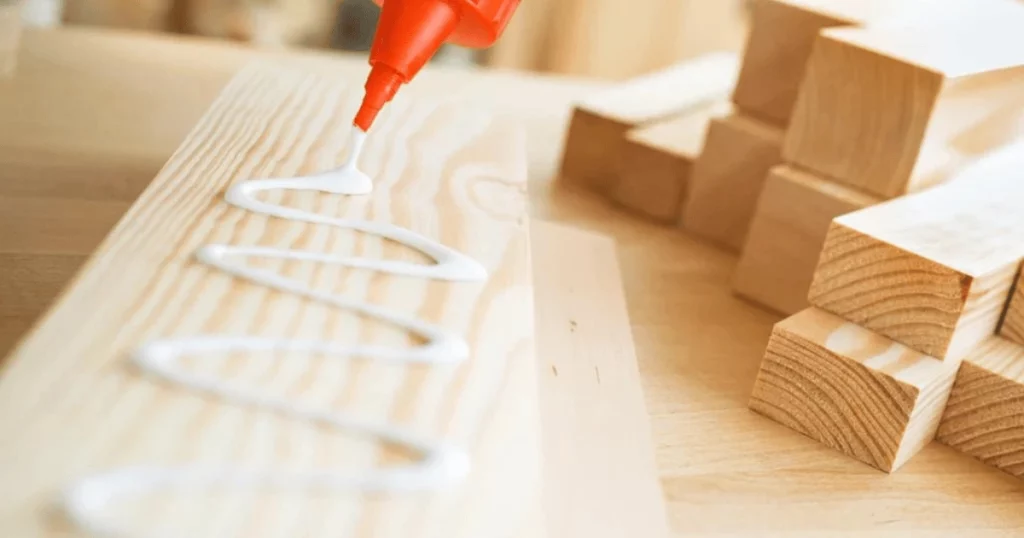
Wax and oil-finished wood
Mechanical removal of wood glue residue or wood glue stains from wax or oiled wooden surfaces is the best option. Solvents and acids will damage the coating too, and you will have to sand the affected region anyway. So, there is no reason to do an additional job just to remove glue from wood.
In addition, restoration of a wax or oil sealing is much easier. After reapplying such sealants, the difference between the original seal and the new one is almost invisible.
Painted wood and varnished wood
Painted wood and varnished wood is the trickiest surface to remove wood glue residue from. A dried glue stain and a topcoat are both polymers, so, in general, are sensitive to the same factors of influence.
But fortunately, differences in physical and mechanical properties are enough for you to be able to remove wood glue stains, splatters, and bids of wood glue without damaging the underlying surface. It will require some extra care, though.
Other surfaces
Other surfaces that can get stained by wood glue include but in any way are limited to concrete flooring of your workshop, fabric, wooden flooring, tile, and numerous others. Wet wood glue stains on fabric are one of the worst cases, as it soaks inside the fiber.
While you can just scrape splatter, drops, and the rest of the excess off a concrete floor with a scraper or a putty knife, getting rid of glue that got stuck inside the fabric without damaging it is way harder. I would even say it’s a lost cause. Especially if the stained piece holds no sentimental value.
Pro-tip: If your workshop has a concrete floor then letting all the splatter dry and scraping it off with a spatula, scraper, or putty knife is the best practice in terms of effort and time efficiency.
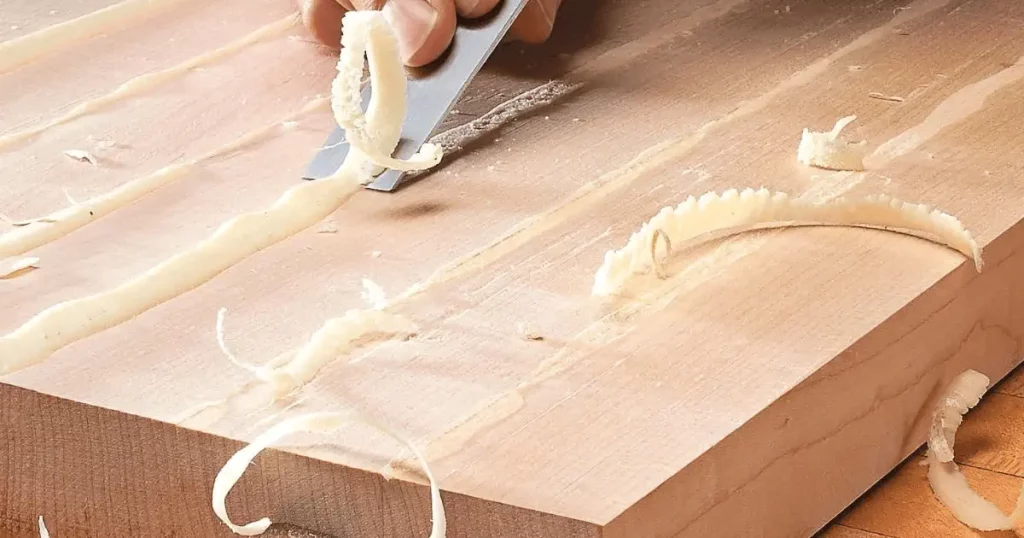
Mechanical removal of dried wood glue stains
Mechanical removal of dried wood glue from wood includes sanding, scraping, chipping, and heating the dried glue. All those methods come with a risk of damaging the underlying layer of paint or wood stain wood but if performed carefully are effective.
Sandpaper and sanders
Some sandpaper on a sanding block or even a sanding machine is the most common way of removing dried glue from wood. It is commonly used by professionals in their projects to remove larger or tough glue stains.
The implementation is pretty straightforward. You just wait for the glue to dry up and sand it down afterward. There is no need for rough grit, so 200 or 300 will work. You can even just go through all the wooden surface preparation as usual.
Tip. Also, see my tips on How to use wood filler for large gaps.
Chip off the thickest chunks with a dull chisel or any other suitable tool to make everything faster. With a bit of practice, you will know exactly how much glue you’ll need to cover the surfaces being glued completely and have the least possible amount of residue.
Steel wool
Steel wool is a gentle abrasive, though a bit rougher than baking soda. It is good for removing wood glue residue from wood surfaces with a wood stain. It is also a practical option to remove glue from wood after some chemical methods. Though, the glossy underlying surface will inevitably get scuffed.
Steel wool is the best method for gently removing wood glue dried into a thin layer that will inevitably stay even after thorough wiping of the residue.
Just carefully consider the roughness of an abrasive you will use to have the least possible amount of damage to the underlying wooden surface. And if you are planning to re-coat the piece anyway, then don’t even bother with it.
Pro-tip: Sanding of unfinished wood will roughen up the grain. Even if steel wool is everything you are using. Spray the sanded region with a bit of water to raise the grain, and then sand it down with lighter grit.
Heat
Under high temperatures, wood glue tends to soften up. A couple of minutes under a usual hair dryer is enough to soften the glue up. A heat gun is a bit more effective for this but can inflict damage to the underlying coat if not used with care.
Heated wood glue splatters and wood glue stains are soft enough to be gently scraped off or even rolled up by hand. But you will have to wait a bit before rolling it away, as the softened glue will be hot.
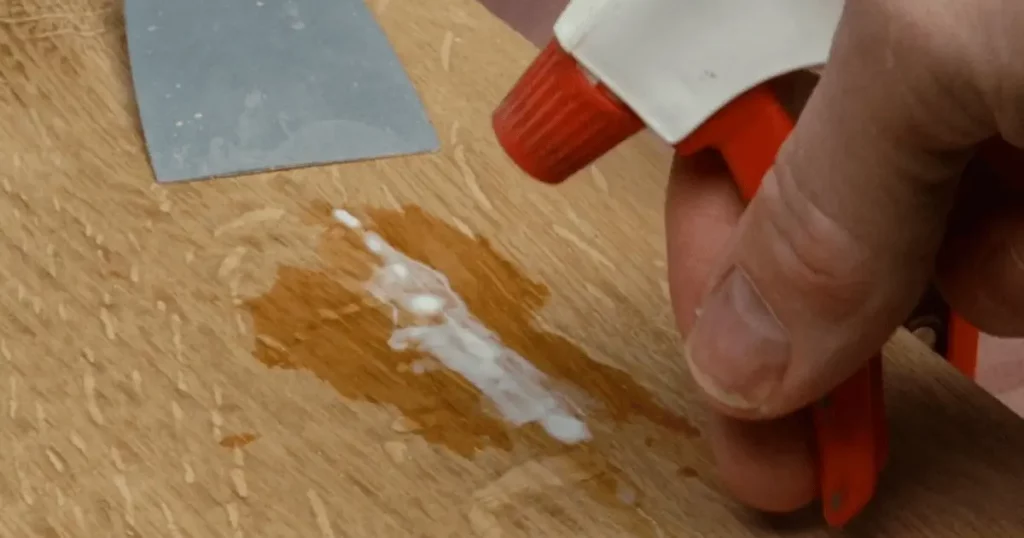
Scrapers and chisels
Chipping off or scraping the dried glue is the best tactic for thick drops and puddles. There is a wide variety of tools that will help:
- a dedicated scraper;
- a dull chisel;
- a putty knife;
- even a side of an unused credit card.
Everything that has a flat edge and is stronger than the dried glue will do. And the whole process is just prying dried bids away from the base surface without damaging it.
How to remove dried wood glue with commercial products?
Commercial products formulated specifically to remove glue from the wood and other materials are the most expensive and the most effective way to clean up the mess. You can find a glue remover in a hardware store or order them online. Some of the most popular options include:
- Goo Gone;
- Goof Off;
- Loctite Glue Remover.
But along with the actual price for the product itself, there are some other features you would want to consider too when deciding to use them to remove dried wood glue.
Efficiency and availability are the main two advantages of Goo Gone, Goof Off, or other commercial wood glue removers. Application of a bit of the product over the residue is all it takes to clean up.
Those advantages come accompanied by several disadvantages:
Pros and cons of a commercial wood glue remover
- Volatile compounds that such products contain.
- Additional safety measures are needed for the application.
- Possibility of messing up an underlying layer of paint or varnish.
- Probability of discoloration and actual chemical damage to the underlying wooden surface.
- Narrow application. Commercial glue removal products for cyanoacrylate glue are different from the ones meant for PVA glues.
So, to successfully use a commercial glue remover, you’ll have to carefully follow the safety recommendations provided by the manufacturer. In addition, you will need to take into account the sensibility of the base material to chemicals in such products.
The need to clean up a large area of the splatter, lack of time, or no other options to remove tough glue stains are the main reasons to go for a commercial product.
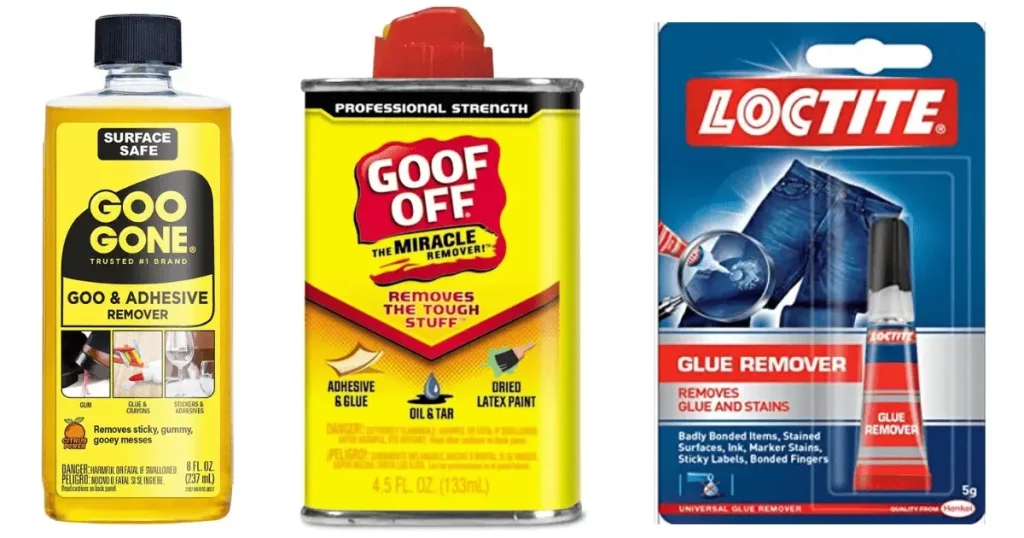
How to remove wood glue? Household products and other life-hacks
The natural sensitivity of PVA glue to acids and solvents opens a lot of opportunities in using usual household chemistry and other products to aid in removing dried wood glue residue. The range of said products is pretty wide-ranging from orange peel to nail polish remover and beyond.
Some wood glues are more sensitive to water but aren’t actually water-soluble. Dried polyvinyl acetate wood glue will absorb water and the bond with the pieces of wood would break, but it won’t get dissolved. In addition, the process will take quite a lot of time.
Pro-tip: Methods of removing wood glue residue based on household items and components are the best for a one-time job. If you are going to glue wood a lot (both as a hobby and work) it is better to adopt common practices like the one I described at the beginning.
Acidic products and natural acids
The acidity of white vinegar, lemon juice, or even 1% citric acid solution is enough to loosen up some dried glue residue. It won’t get dissolved, but surely will loosen up to the point where raised dried wood glue is easily removable with a scraper or a putty knife.
The method of application is less relevant, so you can choose between:
- rubbing on with an acid-dipped cloth;
- soaking up under said cloth;
- just pouting on top of the dried glue and leaving it to soak.
Don’t leave it there for too long, though. Even weak acids can damage the wood fiber through long enough exposure.
Commonly-available solvents
Acetone is your best shot if you want to dissolve some wood glue. It is commonly used as a nail polish remover. The best application method is by dipping a cotton ball into the acetone and rubbing it over the residue.
You can go with mineral spirits too, but such products are a little less effective than a nail polish remover. And you need to be careful when using solvents on painted wood, varnished wood, or unfinished wood. Nail polish remover and similar compounds can dissolve the top coat too, or cause discoloration in the wood.
But the most surprising source of a solvent for unwanted wood glue residue is some orange peels. They contain the only natural solvent. You just need to squeeze some oil from the orange peels on top of the residue, then leave the peels on top of it for half an hour.
Pro-tip: A bottle of commercially produced orange peel solvent is great to have around in your workshop. It is a safe option to dilute some natural finishing products. And it also smells nice.
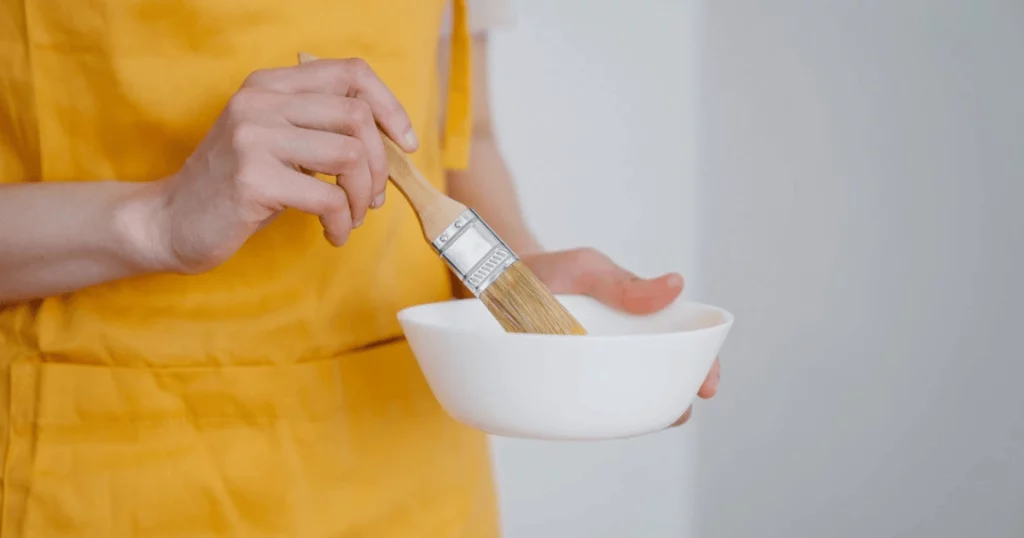
Alcohol-containing products
Isopropyl or other alcohol-containing liquids (including strong liquor) will come in handy when you are trying to remove wood glue from wood surfaces and other materials. Preferably, ones that are not sensitive to alcohol.
Application options are similar to acidic products. But you can be more deliberate as the possibility of damaging the underlying wood surface, other material, or coat is low.
Safety: Alcohol-containing products and most solvents are extremely flammable. Keep all sources of fire and high temperatures away from them while working and storing.
You will have to scrape the softened glue residue after the application of alcohol. Or just gently rub it away with a paper towel. Any of the tools mentioned above will do.
Baking soda
Baking soda (not to be confused with baking powder) is a gentle abrasive. You can pour some on top of the glue residue and gently rub it off with a towel or a tissue. It won’t work well with pools or bids but is a viable method of dealing with thin layers of dried wood glue too.
This fine baking soda powder is still an abrasive, so consider other options for removing wood glue stains that are on glossy surfaces, similar to varnished wood. Even the finest abrasive will make them scratched and cloudy. You’ll be able to polish all the markings from baking soda out but it is additional work.
Pro-tip: Rubbing baking soda with half of a lemon is a great implementation of household chemistry for getting rid of mineral deposits on your sink. It won’t be effective when it comes to removing dried wood glue.
On the matter of vegetable oil
In your searches for ways to remove wood glue, you might see some recommendations for using vegetable oil as a way to remove wood glue. It is just a way to create more mess. Wood glue will not react with oil.
Mayonnaise for removal of dried wood glue
The same goes for mayo. It usually contains some water and acids that may help. Concentrations are way too low to make any difference. You can try it out, of course, but options with some reasoning behind will definitely work better.
Dealing with a wet wood glue stain
If you happen to spill wood glue, don’t panic. Picking up wet glue stains of wet wood glue is the easiest on one hand but on the other, it is less effective. You can use a rag, piece of cloth, or just a towel dampened with hot soapy water to wipe away all the puddles and splatter.
On the other hand, you won’t be able to wipe the wet glue off completely. Especially from the unfinished wood. The wood glue is usually water-based, so adding more water to it will thin down the solution and cause the glue to get stuck on all the uneven areas of the surfaces.
Many woodworkers prefer leaving a liquid glue stain to dry instead, and then sanding it down or chipping it away. Alternatively, you can wipe out the majority of the glue and then use one of the methods described above.
Anyway, your rag, cloth, or towel will become unusable after the wet glue residue dries within the structure of the fabric. And diluted glue will get even deeper into the fiber.
Pro-tip: Wood glue diluted with water is the perfect solution for priming end grain for gluing. Just prepare a thin solution, spread it over an area of end grain that’s meant to be glued, and let it dry. A less viscous mixture will travel deeper inside the wood fiber too and seal it from soaking too much actual glue.
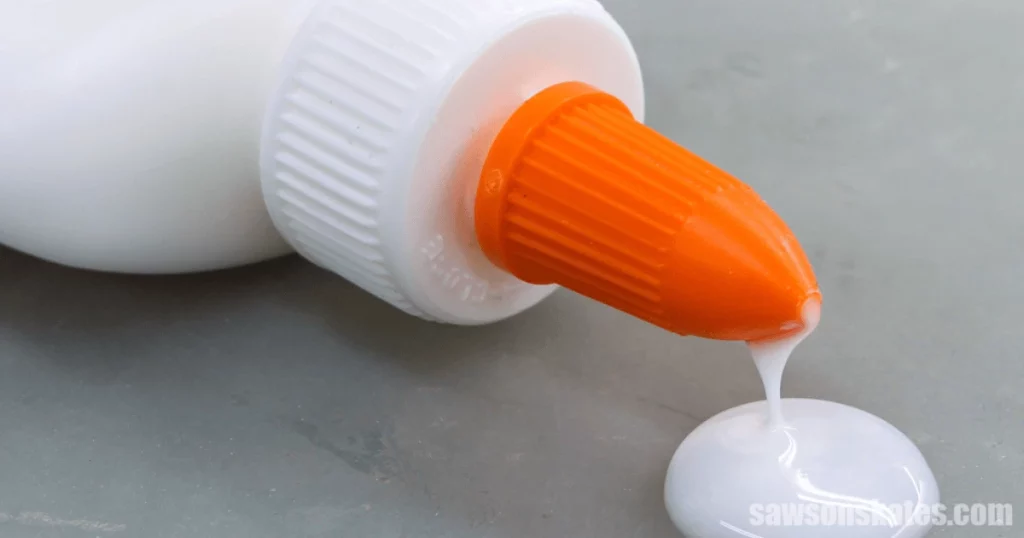
Q&A portion
Now, after figuring out the majority of ways to clean up the dried wood glue residue, I can dedicate some time to answering the most common related questions.
What will dissolve wood glue?
Acetone, alcohol, acids, and dedicated commercial products (Goo Gone, Goof Off, Loctite products) are doing a fantastic job in dissolving wood glue. They won’t dissolve it completely but soften up to the extent of easy scraping off.
Water or oil actually won’t be able to dissolve wood glue. Polyvinyl acetate will soak some of it in and soften it a bit.
But reaching a reasonable amount of loosening up requires too much time to be considered a viable option for removing wood glue.
Is wood glue hard to remove?
It depends on numerous factors, including the type of underlying surface. It is very hard to remove dried wood glue from fabric but you can easily chip it off unfinished wood or concrete.
If the wood surface where the glue landed is meant for finishing, sanding all the dried residue down is the best and the easiest option.
Sometimes a combination of methods allows the fastest, safest, and most efficient way of removing wood glue. So, to be more specific, removing wood glue is not hard. It just either requires a bit of work or is nearly impossible.
How does vinegar remove glue from wood?
Vinegar is a combination of water and acid. Dried glue soaks up some water that brings the acid inside it. The acid breaks down the molecular structure of the polymer formed as a result of drying the wood glue.
Similar processes occur when a citric acid solution is used. Technically, lemon juice is a water solution of citric acid, but some nuances are completely irrelevant to the current subject. It will work anyway.
Does acetone dissolve wood glue?
Acetone or nail polish remover is one of the most effective solvents for polyvinyl acetate-based wood glue.
When it comes to removing wood glue in thin layers of residue, it is the best option. It won’t dissolve thicker drops, puddles, or splatter but will soften them up.
Wrapping it up
So, now you know how to remove wood glue from the wood and other surfaces using the most efficient methods. Use its natural vulnerability to acids, alcohol-containing products, or solvents to dissolve thinner layers of residue.
Go for commercial products if you are going pro or have no time. Use household solutions like nail polish remover to stay cost-efficient.
Sand down, chip off, or roll away after heating big chunks of dried glue. Or just wipe the wet glue away before it is too late. You have all the needed knowledge to be able to successfully clean up some wood glue mess. Use common sense to combine those methods for the best results.

My name is Alex Mashinsky
I am an enthusiastic woodworking hobbyist who created topwoodworkingtools.com to provide helpful information and advice to fellow woodworkers.
The goal of the website is to help readers make informed decisions about woodworking tools and materials, with the ultimate aim of ensuring that they achieve the best possible results from their projects.
My main focus is on offering accurate, honest, and well-reasoned opinions and advice to help readers choose the most suitable tools and materials for their particular needs.
